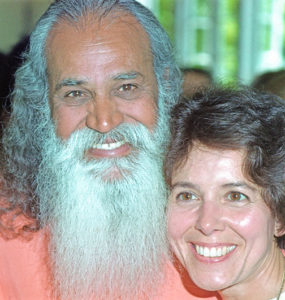 This 8th century CE text describes a conversation between the Lord Siva and his wife, the Goddess Parvati, in which she asks him to teach her about the Guru and liberation. Siva answers her by describing the Guru principle, the proper ways of paying homage to the Guru, and the methods and benefits of repeating the “Guru Gita.”
This 8th century CE text describes a conversation between the Lord Siva and his wife, the Goddess Parvati, in which she asks him to teach her about the Guru and liberation. Siva answers her by describing the Guru principle, the proper ways of paying homage to the Guru, and the methods and benefits of repeating the “Guru Gita.”
It is impossible to find the appropriate words to describe the elation I experience upon arising in the wee hours of the morning before sunrise, with a lightness of body and ease of movements that allow for a careful, fresh and neat preparedness for the anticipated occasion at hand. The day is Thursday—the day of the week traditionally dedicated to the Guru—and the occasion is the reciting of the “Sri Guru Gita” in the Chidambaram Shrine (the Mahasamadhi Shrine of Sri Gurudev Swami Satchidananda).
Traditionally, the “Guru Gita” is offered as a chant. However, when offered as a recitation, accompanied by an alert spirit and a heart open to receive Truth, one slowly becomes aware that in between the words there emerges a cadence, a rhythm, supporting, interweaving and enfolding the recitation transforming it into an intonation that echoes the divine symphony of the universe.
Governed by an infallible divine order, the celestial spheres are suspended in the vast immensity of space, held in perfect balance within the hum of an ongoing symphony whose sound is the veritable voice of the power of love ,without which the Cosmos would simply disintegrate. Sri Gurudev tells us that we live in a “sound universe,” a universe made out of sound. This ineffable melody has been called the “music of the spheres” and is perceived in certain states of consciousness generally achieved in deep meditation.
Since the most ancient times, all spiritual paths of the world have used the intonation of chants as one of the most prevailing methods to transmit their teachings, enrich their liturgies, offer praises and prayers, and for the repetition of sacred mantras. Apart from facilitating the retention of the contents to memory, the greatest benefit of this method is that the intonations, when offered, automatically bind themselves to their corresponding harmonics in the celestial spheres and therefore transport the mystical meaning of the words beyond the confines of the intellect—directly into the most intimate recesses of the soul, thus activating the progressive awakening of the luminous spheres of our own interior cosmos and the magic of its ongoing symphony.
The “Guru Gita” is a splendid exposition of this ancient method. It is called the supreme mantra and considered one of the most precious jewels of the Hindu scriptures. Its author is the sage Vyasa and it forms part of a more extensive scripture, the Skanda Purana. The sage Vyasa describes the instruction imparted by Lord Siva to his consort the Goddess Parvati. Truth can never be taught; it must be imparted. In the same manner, Truth can never be learned, it must be revealed or realized. Herein lies the importance of Guru Tattva, the Guru principle whose meaning is: the light that dispels the darkness.” The Guru is the perennial force of the purifying love of God active in all levels of creation whose function is to transmit or impart to the disciple the changeless eternal light, which the Guru is. This transmission activates the light that lies latent in the consciousness of the disciple. This explains why the first truth imparted in the “Guru Gita” to Parvati is, “Thou art Myself.” From that point onward Lord Siva proceeds to enumerate the conditions necessary for the disciple to maintain the chalice of their consciousness in the proper position and conditions to receive the luminous current proceeding from the Guru, until the moment when, in complete awareness, the disciple realizes: “I am That, I am that I am.”
In practicing the “Guru Gita,” one must keep in mind that it is primordially a mantra and that the text has undergone several translations, therefore it is advisable not to expect to comprehend its total meaning merely through the intellect. Its transforming value is on an energy level, the level of the Spirit and this can only be proven by experience resulting from practice.
The “Guru Gita’s” main object is to transmit the all-pervading nature of the Satguru, the great creator, and its intrinsic oneness with its own expression, the creation. A oneness whose nature is none other than love and whose manifestation is the eternal melody pervading everywhere, even the air we breathe—the eternal song of love.
About the Author:

(Photo: Amma Kidd with Swami Satchidananda, late 1970s.)
Amma Kidd grew up in Nicaragua as part of one of the country’s ruling families. She later moved to New York where she worked at the United Nations. She met her Guru, Sri Swami Satchidananda, in the late 1960s, soon after his arrival in America, and then became his personal and traveling assistant for a number of years. She and her late husband, retired Air Force Major General John B. Kidd, moved to Virginia in the late 1980s, in order to be closer to Satchidananda Ashram–Yogaville. A gifted writer and speaker, after her husband’s death, Amma moved to Yogaville where she regularly gives talks on a variety of topics relating to Yoga and spirituality.

